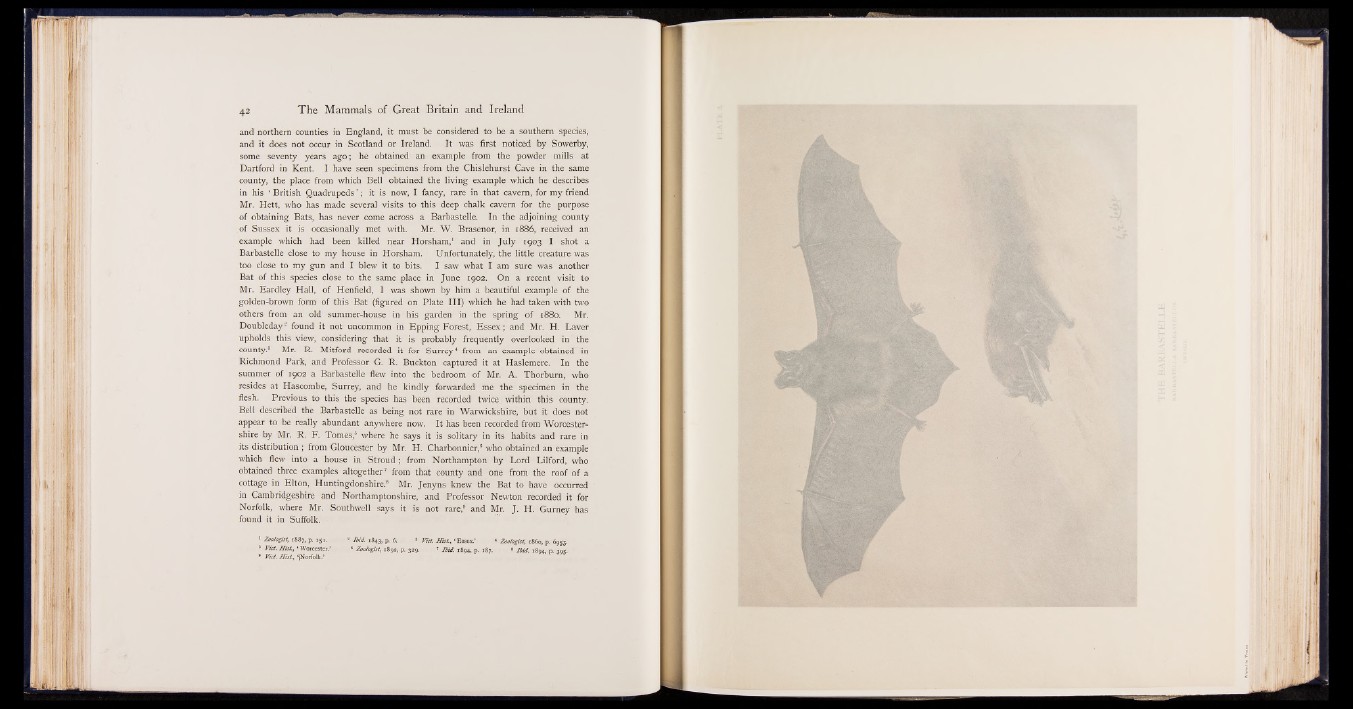
and northern counties in England, it must be considered to be a southern species,
and it does not occur in Scotland or Ireland. It was first noticed by Sowerby,
some seventy years ago; he obtained an example from the powder mills at
Dartford in Kent. I have seen specimens from the Chislehurst Cave in the same
county, the place from which Bell obtained the living example which he describes
in his ‘ British Quadrupeds ’ ; it is now, I fancy, rare in that cavern, for my friend
Mr. Hett, who has made several visits to this deep chalk cavern for the purpose
of obtaining Bats, has never come across a Barbastelle. In the adjoining county
of Sussex it is occasionally met with. Mr. W. Brasenor, in 1886, received an
example which had been killed near Horsham,1 and in July 1903 I shot a
Barbastelle close to my house in Horsham. Unfortunately, the little creature was
too close to my gun and I blew it to bits. I saw what I am sure was another
Bat of this species close to the same place in June 1902. On a recent visit to
Mr. Eardley Hall, of Henfield, I was shown by him a beautiful example of the
golden-brown form of this Bat (figured on Plate III) which he had taken with two
others from an old summer-house in his garden in the spring of 1880. Mr.
Doubleday* found it not uncommon in Epping Forest, Essex; and Mr. H. Laver
upholds this view, considering that it is probably frequently overlooked in the
county.8 Mr. R. Mitford recorded it for Surrey4 from an example obtained in
Richmond Park, and Professor G. R. Buckton captured it at Haslemere. In the
summer of 1902 a Barbastelle flew into the bedroom of Mr. A. Thorburn, who
resides at Hascombe, Surrey, and he kindly forwarded me the specimen in the
flesh. Previous to this the species has been recorded twice within this county.
Bell described the Barbastelle as being not rare in Warwickshire, but it does not
appear to be really abundant anywhere now. It has been recorded from Worcestershire
by Mr. R. F. Tomes,5 where he says it is solitary in its habits and rare in
its distribution ; from Gloucester by Mr. H. Charbonnier,6 who obtained an example
which flew into a house in Stroud ; from Northampton by Lord Lilford, who
obtained three examples altogether7 from that county and one from the roof of a
cottage in Elton, Huntingdonshire.8 Mr. Jenyns knew the Bat to have occurred
in Cambridgeshire and Northamptonshire, and Professor Newton recorded it for
Norfolk, where Mr. Southwell says it is not rare,9 and Mr. J. H. Gurney has
found it in Suffolk.
1 Zoologist, 1887, p. 151. 2 Ibid. 1843, p. 6. 8 Viet. H ist., ‘ Essex.’ 4 Zoologist, i860, p. 6953.
5 Viet- ‘ Worcester.’ 6 Zoologist, 1892, p. 329. 7 Ibid. 1894, p. 187. 8 Ibid. 1894, p. 395.
9 Viet. H ist., ^Norfolk.’